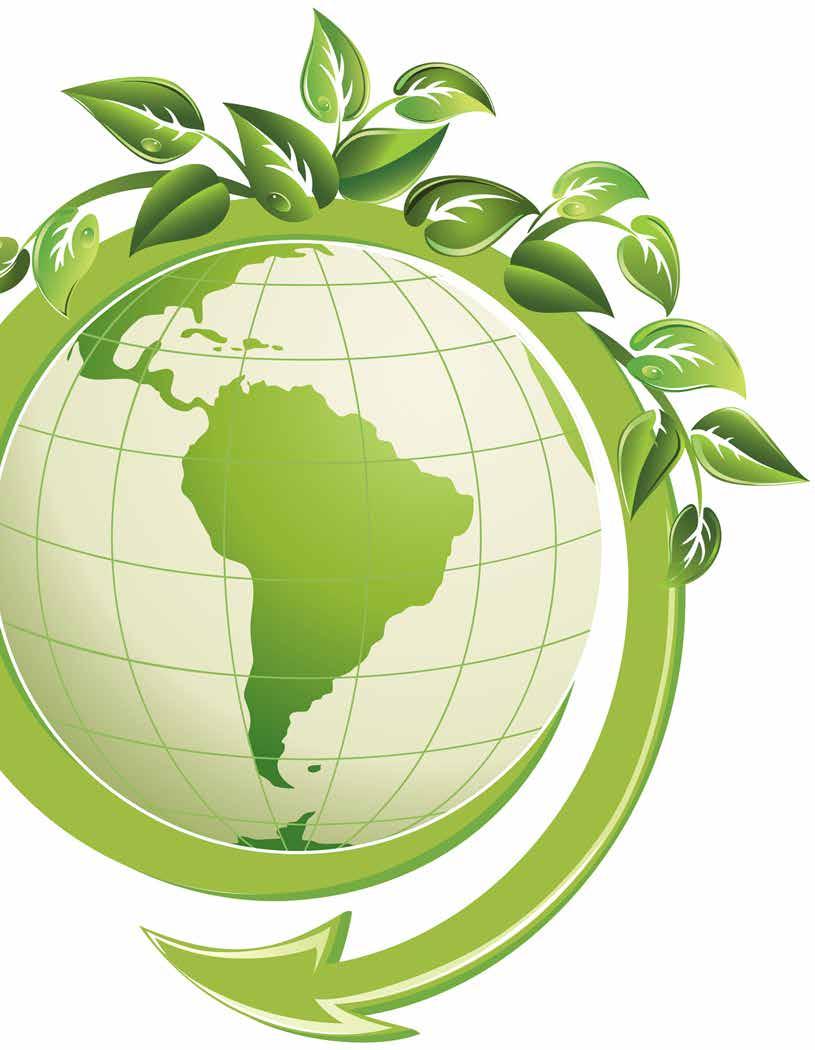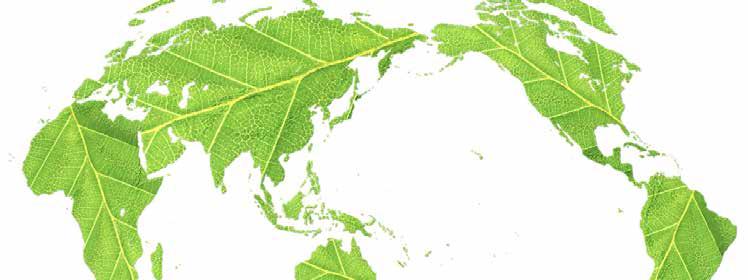
12 minute read
Editorial
from GREEN TECHNOLOGY
Editor in Chief
Naveed Anwar
Advertisement
Editorial Advisor Brahmanand Mohanty
Contributors
Amandeep Sangha Anil Kumar Anal Jai Govind Singh Kanchana Kanchanasut Kriengkrai Satapornvanit Kyoko Kusakabe Pujan Shrestha Sivanappan Kumar Sunandan Baruah Weerakorn Ongsakul
Editorial Team
Kim Escobin Olga Shipina Jen Pangilinan Rakdao Pakdisi
Lay-out and Design
Khattiyanee Khancharee Pitirudee Angkhananuchat
AIT Consulting
consulting@ait.asia www.consulting.ait.asia
ACECOMS
acecoms@ait.asia www.acecoms.ait.asia
km. 42 Paholyothin Highway Khlong Luang, Pathumthani 12120, Thailand
Tel : +(662) 524 6388 : +(662) 524 5533 Fax : +(662) 524 6655
DEAR READER
In this issue of "Technology”, we focus on providing a glimpse of the ongoing global movement for Green Technology through selected research and ideas, all with a distinctly Asian outlook.
This issue covers original research work and results, overviews and opinions, and news covering a wide spectrum of niche knowledge areas such as biotechnology, sustainable production, and tourism, together with the revolutionary potential of smart grids. We also illustrated some of AIT’s contribution to sustainability by featuring the Center of Excellence in Sustainable Development in the context of Climate Change (CoE SDCC) and an innovative Living Laboratory concept that is increasingly gaining momentum.
Several recent projects addressing seismic evaluation and building code requirements as demonstrated through the use of advanced techniques and sophisticated tools are also highlighted as a precursor to next issue’s theme on disaster resilience.
As a forum for professionals and researchers to share and disseminate contributions to the technological development of the Asian region, it is hoped that this issue will stimulate open discussions and support making informed decisions on the some pressing issues we face today.
I would like to thank all the contributors for their generous involvement to ensure that what we do is communicated in the hopes that it will add to green progress.
And lastly, I would like to extend my sincerest invitation to join us in making this publication useful and valuable by sending us your feedback, contributing your own articles, achievements, and opinions on matters relevant to the true advancement of Asia.
Naveed Anwar, Ph.D.
Executive Director, AIT Consulting Director, ACECOMS Affiliate Faculty, Structural Engineering, AIT nanwar@ait.asia
Global Trends : Green Technology
By Brahmanand Mohanty
Global Trends : Green Technology
“G reen”, just like sustainability, has become the buzzword today. Though some people tend to interpret green by the color between blue and yellow in the spectrum, green has a very different connotation for those who are concerned about how our planet earth can continue to thrive and flourish indefinitely without compromising the ability of the future generations to meet their own needs.
Green is intimately connected with the key pillars of human development: the economy, society, and the environment. Sustainability cannot be guaranteed if any of the three pillars is neglected or weakened. Green solutions that will be universally acceptable are those that are comprehensive in nature and are likely to achieve win-win outcomes. Moreover, there is no single silver bullet that can help us attain the green goal. A combination of a number of solutions is needed, and green technology happens to be just one among the many solutions.
Waves of Technological Innovations
Since the beginning of the industrial innovation, the human race has witnessed several waves of technological innovations. As each wave ushered in new innovations, there was fading excitement with the old technologies, and a rising demand for affordable supplies of new goods and services. In the initial period, this wave lasted for 50-60 years, but with the advent of new exciting technologies, the duration of such waves of innovations reduced over time. The early mechanization cycle (water power, textile, and iron) during the 1780s gave way to steam power (steam, railway, and steel) in the 1840s, electricity and heavy engineering technologies (chemicals and internal combustion engines) in the 1900s, followed by the automobile and mass production cycle (petrochemicals, electronics, and aviation) in the 1950s, and the information and communication cycle (digital network, information technology, and biotechnology) in the 1990s. We are now witnessing a new wave of innovation that is distinctly different from the previous ones, the 6th wave of innovation or the “green” Kondatriev cycle named after the Russian economist who introduced the notion of the cycles of technological innovations.
While the waves of technological revolutions brought about huge changes in the lives of human beings, their comfort and well-being, there were clear signs that not everything was going well. As the world became more and more aware of the impacts of human activities on the global environment, two important factors emerged: we were consuming our earth’s precious resources at a much higher rate than nature could replenish, and our industrial activities have resulted in phenomenal growth in carbon dioxide emissions, leading to global warming. With a consumption
6st wave
Innovation
1785 1st wave
Iron Water power Mechanisation Textiles Commerce
1845 Waves of Innovation
2nd wave
Steam power Railroad Steel Cotton
3rd wave
Electricity Chemicals Internal combustion engine
5th wave
4th wave
Sustainabillity Radical resource productivity Whole system design Biomimicry Green chemistry Industrial ecology Renewable energy Green nanotechnology
Petrochemicals Electronics Aviation Space Digital networks Biotechnology Software information technology
1900 1950 1990 2020
Figure 1: Cycles of technological innovations Source: Ernst von Weizsacker et al, 2009
pattern that is likely to result in the bankruptcy of natural resources, we are now faced with the dual challenge of exceeding our biological footprint and contributing to climate change.
The Challenges We Face at This Juncture
Let us have a look at the challenges the humanity faces at present. The world population crossed 7 billion in 2011 and the U.N. Population Division projects the world population to exceed 9.5 billion by 2050, with 58% as Asia’s share.
A recent study conducted by CSIRO (Australia) in collaboration with UNEP shows that the domestic materials consumption for the Asia-Pacific region has increased from 6.2 billion tons in 1970 to 37.8 billion tons in 2008, surpassing the rest of the world in 2005. The modest impact of the global financial slowdown on the rate of per capita domestic materials consumption reinforces the belief that there is little evidence for a tendency towards the dematerialization of growth in the Asia-Pacific region. While the population grew at a rate below 2% per annum, the extraction of four major categories of primary materials has increased significantly over the period 1970-2008: the construction minerals consumption increased 12-fold, metal ores and industrial minerals 8-fold, fossil fuels 6-fold, and biomass almost doubled. Growing affluence along with increasing materials intensity appears to be the most important driver of growing extractive pressures on the environment, while population growth is seen as the least important driver. This means any efforts to stabilize the exploitation of natural re
Author:
Brahmanand Mohanty, Ph.D.
Visiting Faculty, Energy School of Environment, Resources and Development, Asian Institute of Technology
sources will need to address not only materials intensity but also affluence, as stabilizing population is unlikely to grant much reprieve from growing environmental pressures.
Green Technology as an Integral part of the 6th Wave of Innovation
All the human and material progresses that we see today are the fruits of successive technological innovations. Howthe strong correlation between our industrial activities and the increase of carbon dioxide concentration in the earth’s atmosphere. The onus is now on us to make use of our technological prowess for seeking and adopting corrective measures in order to handle the problems we created. There is also the realization that maintaining status quo is not the answer; we need to go beyond and create a regenerative system that assists Nature in sustaining the growing population.
So what are the solutions we need to preconize? The industrial development model we adopted at the beginning of the industrial revolution needs to be revisited. At that time, our population was less and our natural resource base was very large. Today the situation has radically changed as we have to hunt further and deeper for the limited natural resources in order to meet the need of a vast population base. There is growing realization that technologies that were mobilized to exploit the resources for satisfying human needs are grossly inefficient.
Consider these facts: less than 3% of the energy in fossil fuels we consume keeps us comfortable in hot or cold climates, and less than 1% of the energy in gasoline or diesel moves us in an automobile. We can no longer afford to use our finite resources in such a wasteful manner and have to innovate in order to achieve dramatic improvement in the overall resource conversion efficiencies. Examples of technologies that are already helping us move in this direction include LED (Light Emitting Diodes) that are able to provide the desired level of lighting by dividing the energy input by a factor of 8 to 10, and the modern modes of transportation that able to move us from one point to another much faster and in utmost comfort while using only a fraction of energy that is needed for individual cars.
Nature Leading the Way
With the passage of time, we have realized that Nature is in fact a great innovator and we would benefit immensely if human technological innovations could be inspired by the way nature is able to maintain symbiotic relationships and eliminate altogether the notion of “waste” (waste of one specie being the food for another). By observing Nature carefully, scientists are able to imitate Nature’s ways and redesign industrial systems to help us eliminate the very notion of waste and facilitate the shift towards “closed loop” models and “circular economy”. According to the Ellen MacArthur Foundation, a circular economy ensures enhanced flows of goods and services by seeking “to rebuild capital, whether this is financial, manufactured, human, social or natural”. The circular economy follows 4 basic principles:
Create continuous cycles of both biological and technical ‘nutrient’ (products made from pure components that can be easily dissembled and used to create new products)
Energy of the system must come from renewable sources
ever, the scientific community has emphatically proved Mining/materials manufacturing
Farming/collection Recycle remanufacture
Reuse/ redistribute Maintain
Biological materials
Soil restoration
Biosphaere
Biochemical feedstock
Biogas Cascades
Anaerobic Energy recovery
digestion/ composting
Extraction of biochemical Material/parts manufacturer
Product manufacturer
Retail/service provider
Consumer
Collection User
Collection
Technical materials
Refurbish/
feedstock Leakage - to be minimised
Land ll
Figure 2: The industrial system that is restorative by design Source: The Ellen MacArthur Foundation
Prices should reflect the real cost of our activity
Systems should reflect the idea that in nature all of the interdependencies feed into and benefit from one another
The system diagram (Figure 2) illustrates the continuous flow of technical and biological materials through the ‘value circle’.
Examples of Biomimetic Approaches
There are many examples of the application of biomimetic approaches that have changed the way we think and innovate. The Eastgate Centre in Harare, Zimbabwe’s largest office and shopping complex is an architectural marvel in its use of bio-mimicry principles. The building has no conventional air-conditioning or heating, yet stays regulated year round with dramatically less energy consumption using design methods inspired by indigenous Zimbabwean masonry and the self-cooling mounds of African termites. While the outdoor temperature changes throughout the day, the inside of a termite mound holds steady at a temperature that is comfortable for the termites.
The tubercles on the leading edge of humpback whale flippers help them to glide through the ocean with greater ease. By studying the bumps on the humpback whale’s flipper against the smooth flipper found on other whales, scientists have estimated 32% less drag and 8% rise in lift from the bumpy model. This idea has been applied to wind power in order to increase efficiency.
Water is a scarce commodity in deserts. The Onymacris ungulcularis is a beetle found in the Namibian desert that has the most unique way of procuring water. When the dew-enriched fog settles over the dunes early in the morning, the beetle goes to the peak and positions its body in such a way that it helps in dew formation, and slurps up the water thus formed. Engineers have imitated the technique to create the “Dew Bank Bottle” that is ideal for the nomads in the desert. The steel body helps to assimilate the morning dew and channel it into the bottle immediately.

Figure 3: Dew Bank bottle designed by Kitae Pak Source: Yanko Design
By using similar concept, architects can design dome shelters in deserts to capture sufficient amount of water and meet the basic water need of the population lacking access to clean water.
Can Green Technology Become the Panacea to All Our Ills?
Being aware of the fact that it is the growing affluence and not the population growth, which is the most important driver of growing extractive pressures on the environment, it would be a fallacy to believe that green technology alone can solve the key challenges that the humanity faces today. Growing affluence, per se, is not negative, especially in an inequitable world where two-thirds of the population is at the base of the wealth pyramid with only a paltry share of around 3.3% of the global wealth. But along with the growing affluence of those at the base of the pyramid, there is an urgency to make a clear distinction between the “need” and “greed”, with the growing knowledge that we live in a planet with finite resources that should not be exploited and regenerated to continue sustaining the human race on earth.
Metal (stainless steel) with cold properly gathers water in air. (The reason that much of dewdrops are gathered to surface of glass or metal at dawn is because the surface gets colder than air)
Uneven form creates more dewdrops by widening superficial are of air.
Narrow gap with the size to permit only water drops prevents the contamination by foreign material and the dispossession of waters by wildlife.
References
Weiz sacker, Ernst von et al (2009) Factor Five: Transforming the Global Economy Through 80% Improvements in Resource Productivity : a Report to the Club of Rome, Earthscan
The Ellen MacArthur Foundation (July 2013) http://www.ellenmacarthurfoundation.org/circular-economy/circular-economy/ interactive-system-diagram
Yanko Design (May 2010) http://www.yankodesign. com/2010/07/05/beetle-juice-inspired/









